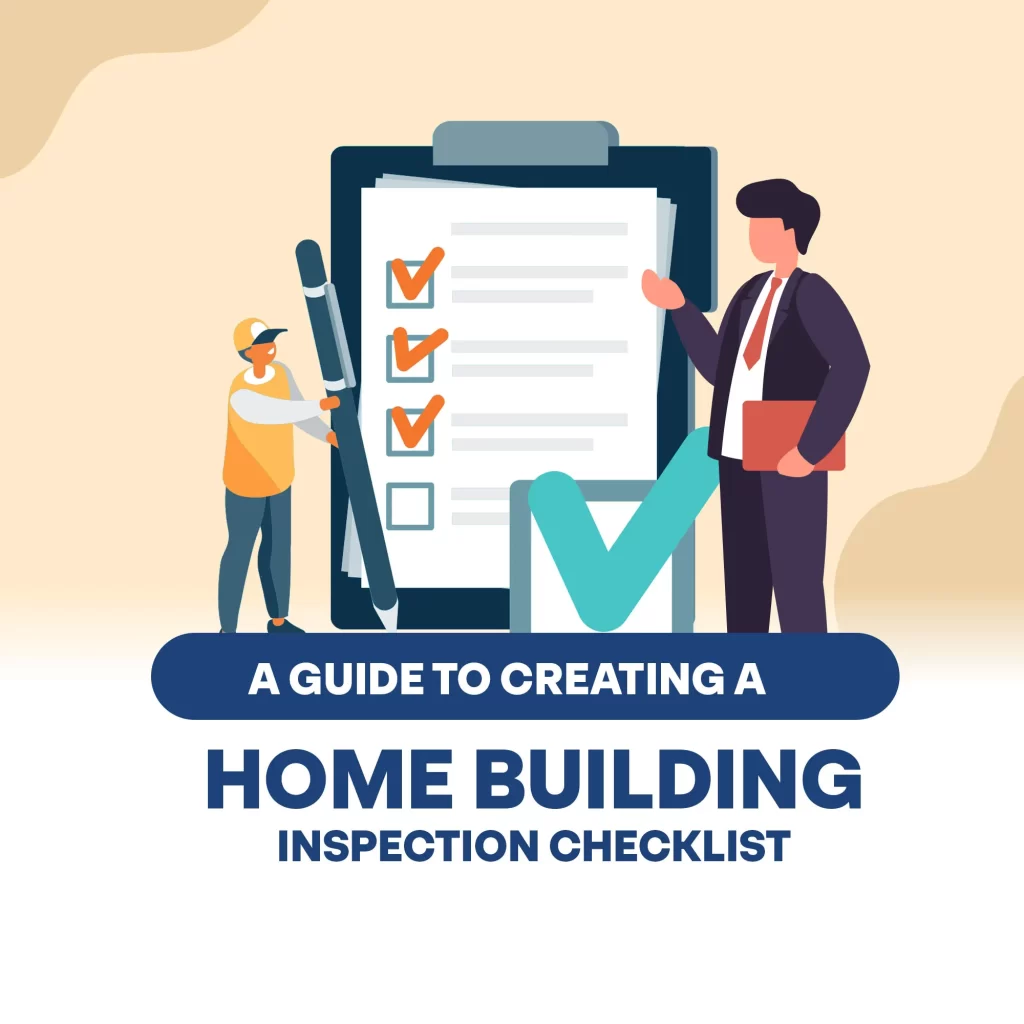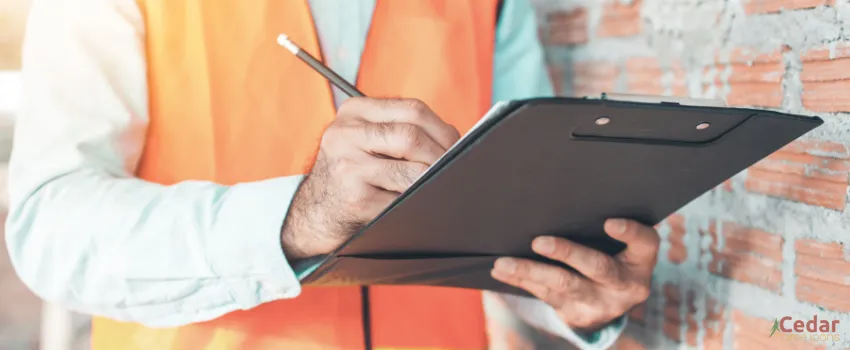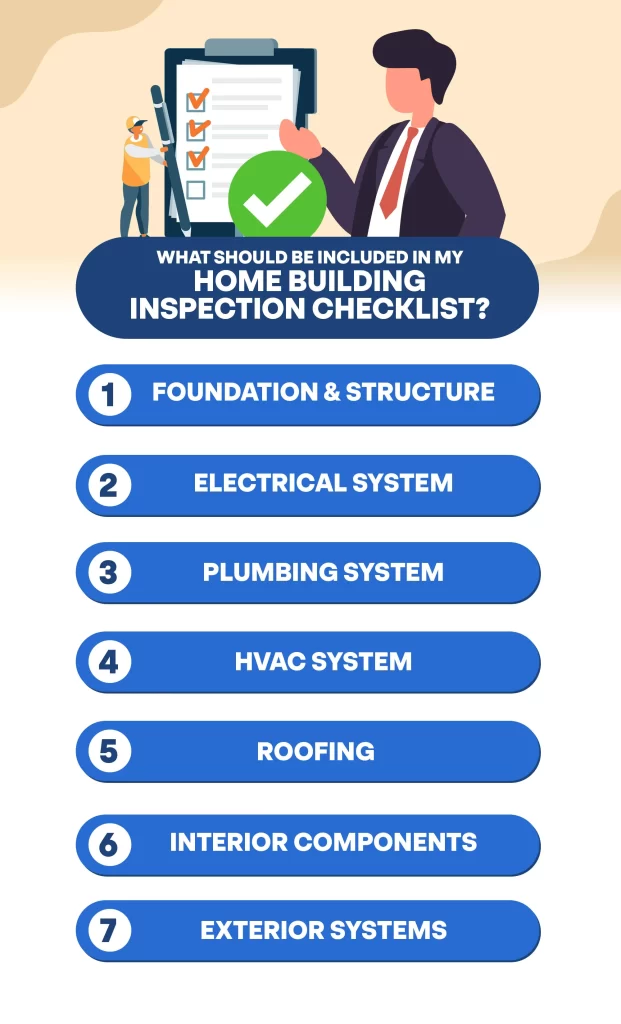Building a new home takes time and money due to extensive planning and design, site preparation, construction material, labor costs, customization and upgrades, inspections and approvals, financing and interest expenses, landscaping, and exterior features.
As a homeowner, it’s natural that you want everything to go smoothly during construction because one flaw could set back the process and cause delays. That’s why it’s essential to have a home-building inspection done at various stages of construction.
A home inspection can help identify potential problems and ensure your new home is built to the highest standards. Learn more about home building inspection below and how to create a home building inspection checklist.
What Is the First Thing You Need to Do When Building a House?
The first thing you need to do when building a house is to find a suitable location. This includes considering zoning, access, topography, view, and price factors. Once you have found a suitable location, you can begin hiring a builder, designing your home, obtaining the necessary permits, and beginning construction.
What Is a Home Building Inspection?
A house building inspection thoroughly assesses a recently built residential residence. It is sometimes called a construction inspection or a pre-delivery examination. A building inspection happens while a new home is being built or finished, as opposed to a standard home inspection, which happens before buying an existing home.
A house-building inspection is performed before the buyer takes ownership of the property. It is done to ensure the construction complies with the necessary standards, building codes, and specifications and to spot potential problems or flaws.
Buyers can objectively evaluate a property’s home systems, structural integrity, and general condition through a home construction inspection. A certified inspector typically performs an in-depth assessment of a residential property’s condition during a home building inspection.
The home inspector will use specialized instruments and equipment during a home construction inspection. Using their tools, they will evaluate the property’s condition on the checklist for home building inspection and pinpoint any areas needing adjustments, replacement, or repair.
The Importance of a Home Building Inspection
1. Identifies Construction Defects
A building inspection identifies any construction flaws or shortcomings in a newly built home. It enables the early detection of problems such as defective wiring, plumbing leaks, structural difficulties, or poor installations.
Identifying these issues before taking ownership of the property allows the buyer or homeowner to discuss them with the builder. It also ensures that any repairs or changes are completed immediately.
2. Ensures Building Codes Compliance
Building codes and regulations are in place to assure building safety, structural integrity, and quality. A house building inspection ensures the structure complies with these codes and requirements.
If any non-compliance concerns are detected, the inspection report can be utilized to correct the issues and verify that the property is following the applicable regulations.
3. Catches Mistakes and Issues Early
Buying or developing a home is a substantial financial commitment. A thorough building inspection protects your investment by identifying problems that could lead to costly repairs or upkeep. Addressing these concerns early on can save the buyer or homeowner money and provide peace of mind.
4. Negotiates Repairs or Discounts
The results of a building inspection might be used as a starting point for discussions with the developer or builder. Before concluding the transaction or purchasing the property, the buyer may demand corrections for flaws, faults, or compensation. The inspection report aids in determining whether any warranties or guarantees offered by the builder are effective.
5. Provides Peace of Mind
A house building inspection gives the buyer or homeowner peace since they know that a qualified, impartial specialist has carefully examined the property’s construction and found any potential problems. It assures the investment made and guarantees that the asset satisfies the anticipated requirements for quality and safety.
Who Pays for a Home Construction Inspection?
You will be the one to pay for a home construction inspection. Before making a checklist for building a house, you must be prepared to cover the cost of home inspection out-of-pocket. It’s best to set a budget for home construction inspection to protect yourself from building a heavily-flawed home.
How Much Does a Home Building Inspection Cost?
As of 2023, the average home inspection cost can range from $200 to $500, depending on the home’s size, age, and location. To get the best estimate, contact prospective home inspectors, who will give you a price range depending on the mentioned factors.
What Is the Checklist for Building Inspection?
Most of the time, evaluators follow a home building inspection checklist to streamline the process. This checklist includes checking the foundation, roof, electrical and plumbing systems, HVAC (heating, ventilation, and air conditioning) system, insulation, walls, windows, and other visible structures.
What Is a Construction Checklist?
A construction checklist is a tool used to ensure that all necessary steps and tasks are completed during a construction project. It outlines the key activities and milestones that need to be achieved, such as obtaining permits and conducting inspections. By following the construction checklist, project managers and contractors can stay organized, track progress, and ensure that nothing is overlooked during the construction process.
How Do I Make a Checklist for a Building?
To create a home building inspection checklist, start by identifying the key areas and systems to assess. These areas include the foundation, walls, roof, electrical wiring, plumbing, and HVAC. Break down each area into specific components or tasks, such as checking for cracks, water leaks, proper insulation, and functioning appliances.
Ensure the checklist covers interior and exterior aspects of the building and includes spaces to note any observations or issues discovered during the inspection. Regularly review and update the checklist to ensure it addresses all necessary aspects of a thorough home-building inspection.
What Should Be Included in My Home Building Inspection Checklist?
Handling an inspection can be overwhelming since you will look into various aspects of your newly built home. With the help of a professional inspector and a well-detailed home building inspection checklist, you will have a more seamless experience. Here’s what your checklist for building a house should include:
1. Foundation and Structure
The first item on your new home construction checklist is the foundation and structure of your newly built home. To do this, you must:
- Examine the foundation walls, floors, and settlement for any signs of water intrusion, such as cracks or settlement
- Check the foundation’s integrity for shifting, bulging, or unevenness.
- Analyze the quality of the foundation’s drainage and waterproofing systems.
2. Electrical System
Next on the home building checklist is the electrical system. You and the inspector should:
- Verify the electrical wiring’s installation, grounding, and adherence to the relevant electrical codes.
- Check the operation of the light fixtures, switches, and outlets.
- Examine the electrical panel to ensure it is appropriately labeled, has enough power, and has safety features like circuit breakers or fuses.
3. Plumbing System
It’s also vital to include checking your plumbing system as part of your home building checklist. Checking this includes:
- Examining the plumbing installations for leaks, corrosion, and indicators of incorrect installation, including pipes, fixtures, faucets, drains, and supply lines.
- Testing the sinks, toilets, showers, and bathtubs.
- Examining the water heating system, including the water heater, for good operation and safety features.
4. HVAC System
It also helps to include the heating, ventilation, and air conditioning systems (HVAC) in your home building inspection checklist. Here’s how you can inspect the HVAC:
- Examine the heating, ventilation, and air conditioning systems, as well as the equipment, ductwork, filters, and thermostats.
- Test the HVAC system’s functionality to ensure optimum heating, cooling, and air movement.
- Inspect the insulation surrounding HVAC ducts to ensure good sealing and energy efficiency.
- Look at the insulation materials used and how well they were installed in the walls, ceilings, and floors. Doing so guarantees proper energy efficiency and temperature control.
- Evaluate the ventilation systems, including exhaust fans, attic vents, and air circulation, to avoid moisture buildup and maintain indoor air quality.
5. Roofing
It is necessary to check the roofing during a home construction inspection to guarantee the building’s structural integrity, weather protection, energy efficiency, and safety. Here are a few things to do to check your roofing:
- Inspect the roof covering for evidence of damage, loose or missing parts, or incorrect installation, including shingles, tiles, or other materials.
- Examine the flashings around chimneys, vents, and skylights to check that they are watertight.
- Check for correct installation, alignment, and performance of the gutters and downspouts.
6. Interior Components
Add interior components to your new home construction checklist to inspect the quality of your interiors. Some of the areas you should observe for your new home construction checklist include:
- Look for cracks, unevenness, or indicators of poor workmanship on the walls, ceilings, and flooring.
- Check the stairs, railings, and fences for stability, sound installation, and safety.
- Examine the cabinetry, countertops, and other interior finishes for quality and practicality.
- Check that installed appliances, including ovens, cooktops, refrigerators, and dishwashers, are working correctly.
- Check all the appliances in the kitchen and the bathroom to make sure they are working correctly and to look for any leaks or other issues.
7. Exterior Systems
Conducting a thorough inspection of the exterior systems during a home construction inspection is critical for addressing issues. Here’s what you need to look out for:
- Check the windows and exterior doors to see if they’re properly installed and aligned.
- Evaluate the exterior siding’s installation, alignment, color consistency, and material quality.
- Inspect the handrails of patios, porches, and decks.
- Ensure that the water flows away correctly from the foundation by checking the grading and drainage.
- Check for signs of damage and the quality of construction of exterior elements, including decks, patios, and driveways.
What Happens When an Inspector Finds an Issue During the New Home Inspection?
Unfortunately, not all home inspections go smoothly. In some rare instances, a home inspector can uncover major issues you should address immediately. The severity of the issue determines the course of action. The homeowner or builder can address minor issues, while major issues may require professional repairs.
It’s important to remember that the list of common concerns discovered during house inspections is not exhaustive. The specific issues found can vary based on the home’s age, location, and condition.
A thorough inspection by a skilled specialist can assist in identifying these concerns and making recommendations for necessary repairs. Sometimes, the buyer may negotiate with the seller to address the problems before finalizing the purchase. Alternatively, the buyer might decide not to proceed with the purchase if the issues are significant or beyond their budget to fix.
Key Takeaway
Creating a home building inspection checklist guarantees your new home is built to your standards. By creating a checklist, you can ensure the inspector will get everything necessary. Be sure to include all of the critical areas of the home, such as the foundation, framing, roofing, plumbing, electrical, and HVAC systems.
After creating a checklist for building a house, review it with the inspector before the inspection begins. This will help to ensure that the inspection is thorough and that you are satisfied with the results.
Securing your home funds is more affordable with Cedar Home Loans.
After finalizing your inspection checklist, let Cedar Home Loans help you secure more reasonable home financing. Our knowledgeable staff can assist you in locating the best loan for your needs from the range of loan options we provide. Contact us now to learn more about our Boulder home loans and how we can support your efforts to become a homeowner.









